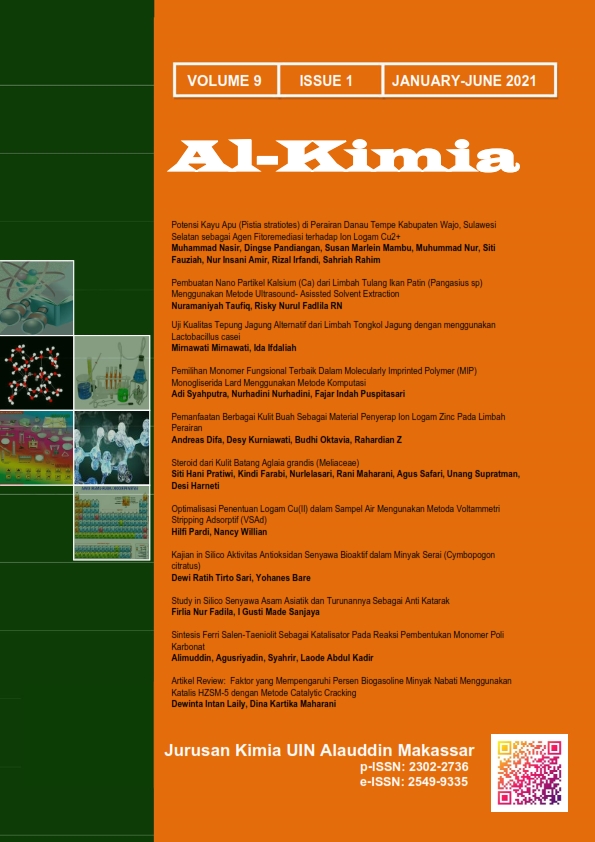Potensi Kayu Apu (Pistia stratiotes) di Perairan Danau Tempe Kabupaten Wajo, Sulawesi Selatan sebagai Agen Fitoremediasi terhadap Ion Logam Cu2+
Abstrak
Lake Tempe is a technical lake that stretches across three districts in South Sulawesi, namely Wajo Regency, Sidendang Rappang Regency and Soppeng Regency. Because of its vastness, people use the lake for various activities, one of which is the textile industry. The textile industry uses a lot of chemicals which are then dissolved in water. These materials contain suspended solids, organic substances and heavy metals. The washing stage is the final process of the textile industry. The waste product is liquid waste containing heavy metals, including copper (Cu). To reduce or remove Cu metal found in Tempe Lake, phytoremediation techniques are used. Phytoremediation is an effort made to remove hazardous substances in areas contaminated with waste by using plants that have phytoremediator properties. Water plants that can be used are apu wood (Pistia stratiotes). The purpose of this study was to determine the ability of apu (Pistia stratiotes) to remediate Cu2 + in contaminated Lake Tempe water. The research method used included: Cu2+ assay, physicochemical analysis, Bio-Concentration Factor (BCF) and identification of functional groups. The greatest adsorbed Cu metal ion on apu wood is on the 10th day of 100,274 mg / Kg.
##plugins.generic.usageStats.downloads##
Referensi
Baxter, T.E. (2017). Standard Operating Procedure Total Dissolved Solids by Gravimetric Determination. Retrieved from https://www.cefns.nau.edu/~teb/ambl/ sop/SOP_AMBL_105B_TotalDissolvedSolids.pdf.
Farnese, F.S., Oliveira, J.A., Lima, F.S., Le~ao, G.A., Gusmana, G.S., Silva, L.C. (2014). Evaluation of The Potential of Pistia Stratiotes L. (Water Lettuce) For Bioindication and Phytoremediation of Aquatic Environments Contaminated With Arsenic. Braz J Biol. 74(3):108–112. doi:10.1590/1519-6984.01113.
Haerunnisa, B., Syamsu, A.A., & Andi, I.B. (2015). Management Model of Sustainability Fisheries at Lake Tempe, South Sulawesi, Indonesian. International Journal of Science and Research (IJSR). 4 (5) : 2319–7064.
Irawanto, R. (2010). Fitoremediasi Lingkungan dalam Tanaman Bali. UPT Balai Konservasi Tumbuhan Kebun Raya Purwodadi-LIPI, 2(4), 29-35.
Khasanah, M., Moelyaningrum, A.D., & Pujiati, R.S. 2018. Analisis Perbedaan Tanaman Kayu (Pistia stratiotes) sebagai Fitoremediasi Merkuri (Hg) pada Air. Sanitasi : Jurnal Kesehatan Lingkungan. 9(3) : 105-110.
Kari, E., Kratzer, S., Beltrán-Abaunza, J. M., Harvey, E. T., & Vaičiūtė, D. (2017). Retrieval of Suspended Particulate Matter from Turbidity – Model Development, Validation, And Application To MERIS Data Over The Baltic Sea. International Journal of Remote Sensing, 38(7):1983– 2003.
Kementerian Lingkungan Hidup Republik Indonesia (KLHK). (2014). Gerakan Penyelamatan Danau (GERMADAN) Tempe. Retrieved from : http://sipdas.menlhk.go.id/documents/81.
Kumari, A., Lal, B., Rai, & U.N. (2015). Assessment Of Native Plant Species For Phytoremediation Of Heavy Metals Growing In The Vicinity Of NTPC Sites, Kahalgaon, India. Int. J. Phytorem. 18: 592–597.
LaGrega. (2001). Hazardous Waste Management. Mc Graw Hill Inc. New York.
Lu. D., Huang, Q., Deng, C., and Zheng, Y. (2017). Phytoremediation of Copper Pollution By Eight Aquatic Plants
Nugraha, M.F.I., Julzarika, A., Radjamuddin, A., Reflinur, Yunita, R. Enggarini, W. & Novita, H. (2019). Study of Aquatic Plants And Ecological- Physics Tempe Lake, Sulawesi Selatan. TORANI: Journal of Fisheries and Marine Science, 2(2): 105-115.
Fisheries and Marine Science, 2 (2),105-115 Retrieved from. http://journal.unhas.ac.id/index.php/torani
Pehivan, E. Ozkan, A.M Dinc S. and Palayia, S. (2009). Absorption of Cu2+ Pb Ion. Journal of Hazardous Materials. 167: 1049.
Purnawati. (2015). Penurunan Kadar Rhodamin B dalam Air Limbah dengan Biofiltrasi Sistem Tanaman. Bali. Pascasarjana Udayana.
Raissa, D.G. & Tangahu, B.V. (2017). Fitoremediasi Air yang Tercemar Limbah Laundry dengan Menggunakan Kayu Apu (Pistia stratiotes). Jurnal Teknik ITS. 6(2), 7-11.
Rahadian, R.., Sutrisno, E., & Sumiyati, S. (2017). Efisiensi Penurunan COD dan TSS dengan Fitoremediasi menggunakan Tanaman Kayu Apu. Jurnal Teknik Lingkungan. 6(3). Semarang.
Sari, N.W.M., Diara, I.W., & Trigunasih, N.M. (2017). Meningkatkan Kualitas Air Irigasi dengan menggunakan Tanaman Kayu Apu (Pistia stratiotes L). dan Tanaman Azolla (Azolla sip). Di Subak Sembung, Peguyangan, Denpasar. Journal of Tropical Agroecotechology. 6(1), 82-90.
Salt, DE, Prince, RC, Pichering, IJ, dan Raskin I. (1995). Mechanisms of Cadmium Mobility and Accumulation in Indian Mustard, Plant Physiol, 109: 427-433.
Surur, F. (2018). Strategi Adaptasi Nelayan Terhadap Perubahan Ekologis Danau Tempe Di Desa Pallimae Kecamatan Sabbangparu Kabupaten Wajo. 91–102.
Tan, C. W., Thishalini, A., Goh, E. G., & Edlic, S. (2017). Studies on Turbidity In Relation To Suspended Solid, Velocity, Temperature, Ph, Conductivity, Colour and Time. ARPN Journal of Engineering and Applied Sciences, 12(19): 5626–5635.
Victor, K.K, S., Eka, Y., Norbert, K.K., Sanogo, T.A, & Celestin, A.B. (2016). Phytoremediation of Wastewater Toxicity Using Water Hyacinth (Eichhornia Crassipes) and Water Lettuce (Pistia stratiotes). Int J Phytoremed. 18(10):949–955. doi:10.1080/15226514.2016.1183567.
Wirawan, W.A., Wirosoedarmo, R., & Susanawati LD. (2014). Pengolahan Limbah Cair Domestik menggunakan Tanaman Kayu Apu (Pistia stratiotes L.) dengan Teknik Tanam Hidroponik Sistem DFT (Deep Flow Technique). Jurnal Sumberdaya Alam dan Lingkungan, 1(2), 63-70.
Widowati, H. (2000). Peranan Tumbuhan Air sebagai Bioremediator Pencemaran akibat Industri Batik. Tesis S2. Pascasarjana Ilmu Lingkungan, UGM. Yogyakarta.
Zayed, A., Gowthaman, S., Terry, N. (1998). Phytoaccumulation of trace elements by wetland plants: I. Duckweed. Environ Qual, 27: 715–721.
Zhu YL, Pilon,S. E.A.H., Tarun, A.S., Weber, S.U., Jouanin, L.L, and Terry N. (1999). Cadmium Tolerance and Accumulation in Indian Mustard is Enhanced By Overexpressing Glutamylcysteine Synthetase. Plant Physiol. 121: 1169-1177.
Authors who publish with this journal agree to the following terms:
1) Authors retain copyright and grant the journal right of first publication with the work simultaneously licensed under a Creative Commons Attribution License that allows others to share the work with an acknowledgement of the work's authorship and initial publication in this journal.
2) Authors are able to enter into separate, additional contractual arrangements for the non-exclusive distribution of the journal's published version of the work (e.g., post it to an institutional repository or publish it in a book), with an acknowledgement of its initial publication in this journal.
3)Authors are permitted and encouraged to post their work online (e.g., in institutional repositories or on their website) prior to and during the submission process, as it can lead to productive exchanges, as well as earlier and greater citation of published work (See The Effect of Open Access).


